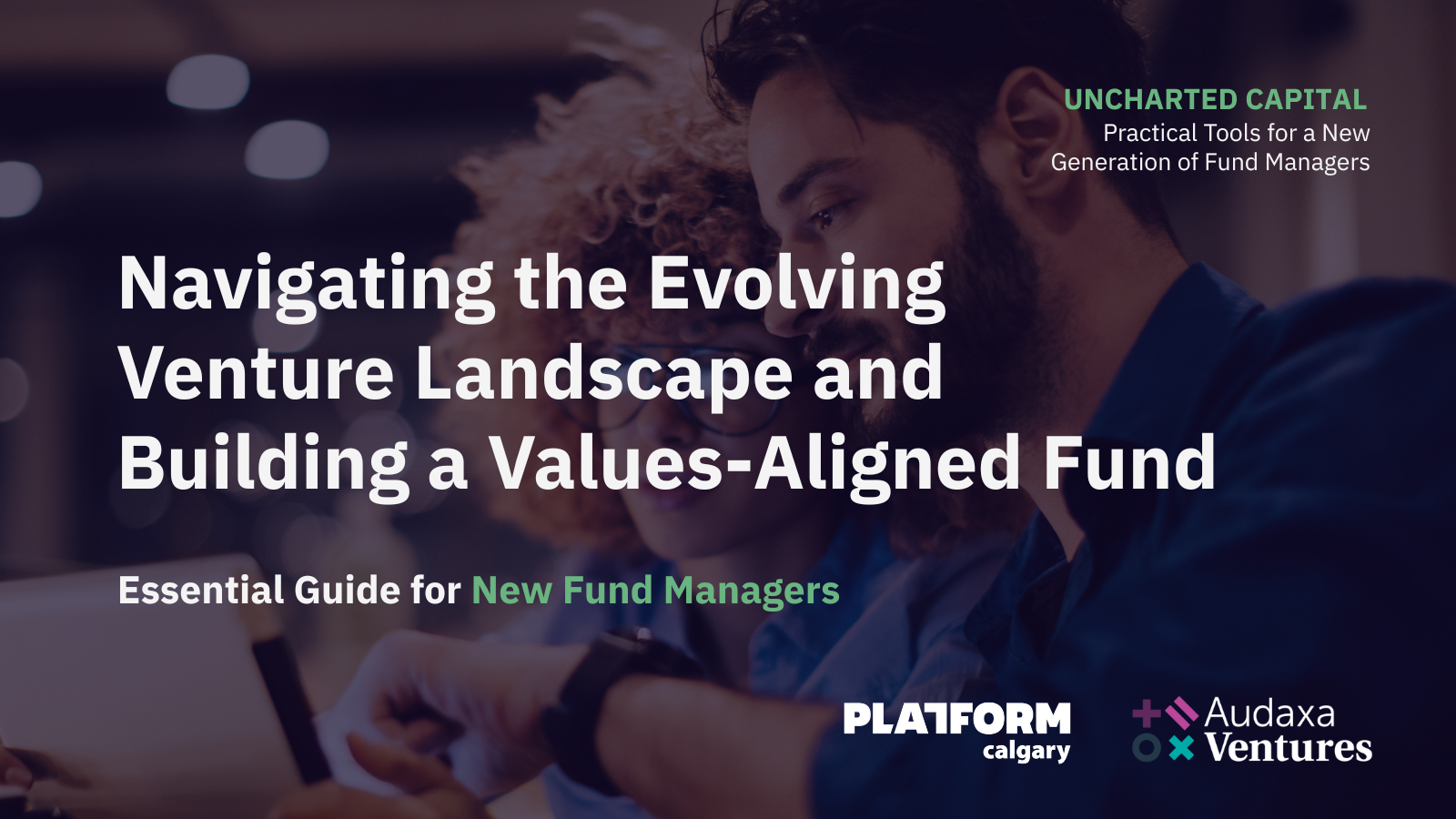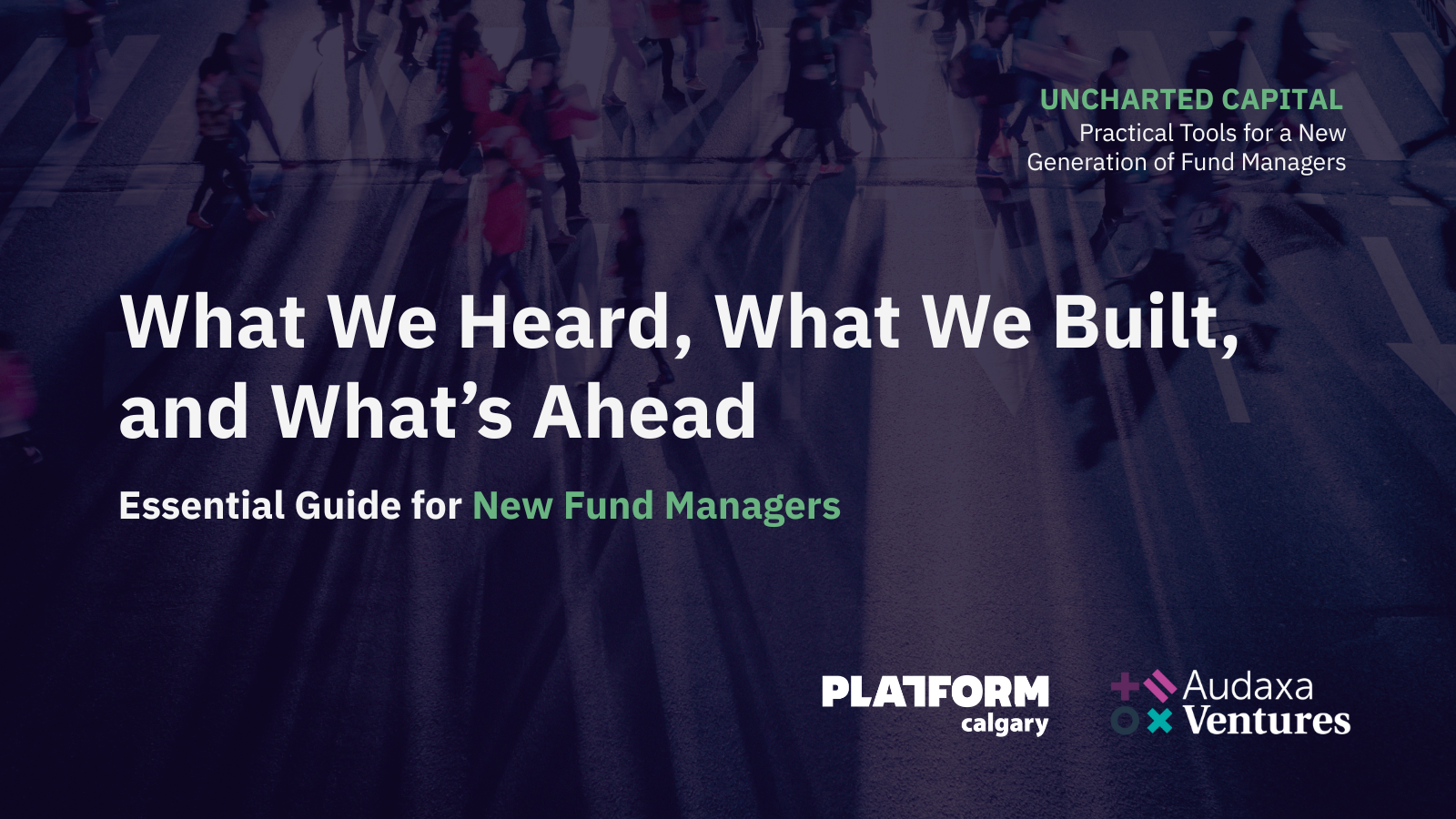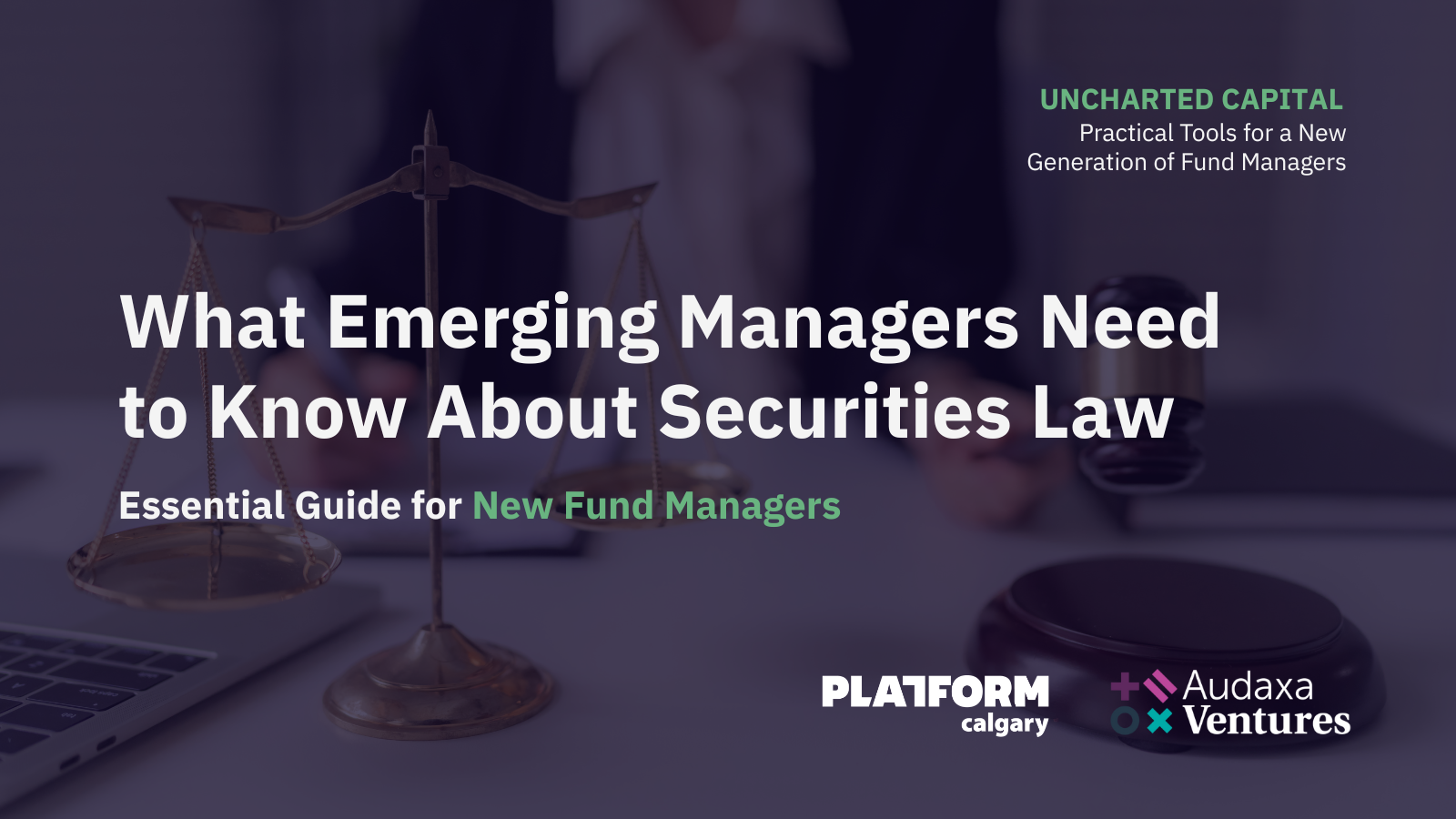Essential Guide for New Fund Managers: Navigating the Evolving Venture Landscape and Building a Values-Aligned Fund

Platform Calgary is a non-profit, member based organization. Our mandate is to bring together the resources of Calgary's tech ecosystem to help startups launch and grow at every step of their journey, from ideation through to scale.
More about Platform CalgaryEssential Guide for New Fund Managers: Navigating the Evolving Venture Landscape and Building a Values-Aligned Fund
By Raissa Espiritu & Hilary Kilgour, Audaxa Ventures in Collaboration with Bilal Rasool, Platform Calgary
As the first in a multi-part series, this chapter is meant to level-set. It offers a high-level overview of the shifting venture landscape, the rise of niche and values-aligned funds, and the foundational questions every new fund manager must confront early. While later chapters will go deeper into fund structure, capital raising, portfolio construction, and LP strategy, this piece is designed to establish a shared understanding of where the market is heading—and where emerging managers can lead with clarity and purpose.
Understanding the Evolving Venture Capital Landscape: Key Insights for New Fund Managers
The venture capital landscape continues to evolve, shaped by market cycles, shifting investor expectations, and the growing need for new approaches to innovation financing. As traditional investors have historically pulled back from early-stage investing during times of uncertainty, a space continues to emerge for a new generation of fund managers—those who are not only capital allocators but also ecosystem builders, community leaders, and operator-backed allies to founders.
This shift isn’t merely cyclical—it’s philosophical. Across regions and verticals, new GPs are reimagining the venture model itself: leaner, more values-aligned, and better attuned to the challenges of today’s economy. Whether driven by regional loyalty, a commitment to diversity, or a personal connection to the problems founders are tackling, emerging managers are building a new way forward in an investment landscape that demands creativity, relevance, and resilience.
This chapter offers enduring insights for new fund managers navigating the complexities of early-stage investing, with guidance that transcends any single moment in time. It explores foundational strategies, common pitfalls, and the emotional realities of building a fund from the ground up.
The Rise of Niche and Values-Aligned Funds
In today’s fundraising climate, LPs—especially family offices, foundations, and institutional allocators—are seeking more than just financial returns. They want alignment. They want intentionality. And increasingly, they want fund managers who are positioned to generate returns in markets and communities that traditional VC has historically overlooked.
This trend is particularly visible in Canada, where a new class of LPs is entering the venture landscape with values-led motivations:
- Family offices focused on legacy, regional impact, or climate resilience
- Indigenous trusts seeking reconciliation and wealth creation within communities
- Foundations and non-profit endowments rethinking their investment strategies to include mission-aligned, early-stage capital
In this context, emerging managers who build funds with a clearly defined investment thesis—rooted in sector, geography, lived experience, or community—are meeting a growing demand for intentional capital deployment. Specificity is no longer seen as a limitation. It’s a signal of focus, credibility, and trust.
Canadian LPs are responding to managers who bring proximity to problem sets—whether that’s supporting women in health innovation, investing in Northern or Prairie-based entrepreneurs, or championing First Nations-led ventures. A strong example is Raven Indigenous Capital Partners, whose sector-agnostic fund is rooted in community empowerment and Indigenous ways of knowing. Their success has opened the door for other values-aligned emerging managers across Canada to bring similarly differentiated theses to market.
Another example is The51, which focuses on gender-lens investing with a strong emphasis on the Prairies. Similarly, Amplify Capital has built portfolios with environmental and social impact as core tenets, demonstrating that focused funds can raise meaningful capital and drive competitive returns.
As the venture ecosystem evolves, more capital is shifting toward solutions at the intersection of climate, health, equity, and technology—and emerging managers are in a unique position to lead that movement. Rather than trying to mimic established generalist funds, the most successful new managers are those who own their specificity and build strategies that reflect not only market gaps, but community needs and systemic opportunities.
Crafting a Differentiated Investment Thesis for Emerging Fund Managers
For emerging managers, a differentiated thesis is your most important tool. In a competitive and cautious LP environment, it’s not enough to say you're early-stage or impact-focused. You need to tell a compelling story about why your fund exists, who it serves, and why you are uniquely qualified to lead it.
While this chapter focuses on defining a differentiated thesis, we recognize that LPs weigh a complex set of factors when evaluating emerging and impact fund managers—including perceived tradeoffs between financial return and mission alignment. We’ll explore these decision criteria in depth in a later piece focused specifically on LP engagement, expectations, and how emerging managers can position themselves effectively within today’s cautious and values-sensitive capital environment.
At its core, your thesis should answer three critical questions:
- Why you? - What lived experience, expertise, or track record do you bring to this market or community? Why are you the person to lead this strategy?
- Why now? - What macro trends, timing, or inflection points make this the moment to launch your fund? How is the opportunity time-bound?
- Why this? - What is the shape of the opportunity? What markets or founders are overlooked? Why will capital deployed here outperform?
Key considerations when designing your thesis:
- Be Specific, but Scalable
LPs want a focused thesis—but they also want to know there’s enough deal flow, market opportunity, and return potential. “Women-led climate ventures in Alberta” is specific and compelling; “Cleantech solutions originating in Canada” is too broad. - Ground It in Insight and Evidence
Draw from research, experience, or prior investments. Cite data and trends to support your thesis (e.g., CVCA reports, SDG alignment, industry tailwinds in clean energy or Indigenous innovation). - Show Alignment Between Fund Design and Strategy
Your thesis should be reflected in your sourcing model, founder support approach, and even your LP base. For example, if you’re investing in underrepresented healthtech founders, your advisors, pipeline, and partnerships should reflect that. - Connect to a Broader Vision
A differentiated thesis should also tie into a larger movement, policy priority, or unmet societal need. In Canada, this could mean aligning with the Truth and Reconciliation Commission’s Calls to Action, United Nations Sustainable Development Goals (SDGs), or Canada’s Net-Zero Innovation goals.
"Your story should be simple, clear in 3 slides or less, deeply personal, and highlight your 'right to win.'" – Emerging Manager Session Participant
Reflective Questions for Crafting Your Investor Thesis
- What do I see in the ecosystem that others are missing?
- Whose voices, regions, or solutions are undercapitalized—and why?
- How do my own values, networks, or experiences inform this strategy?
- Can I explain my thesis in one sentence without losing its power?
Fund Structure Basics and Fund Structure Options
Most emerging Canadian fund managers launch with a traditional Limited Partnership/General Partnership (LP/GP) structure. In this model, the General Partner (GP) is the managing entity responsible for investment decisions, fund operations, and reporting, while Limited Partners (LPs) provide the capital and are entitled to a share of the returns.
The LP/GP structure is widely used in venture capital because it clearly delineates responsibilities and risk, aligns incentives through carry and management fees, and is familiar to institutional investors.
That said, it’s not the only option. Emerging managers are increasingly exploring alternative models that offer different levels of flexibility, control, and fundraising cadence, such as:
- Special Purpose Vehicle (SPV):
SPVs are single-purpose investment vehicles designed to pool capital for one deal or a tightly defined opportunity. They’re often used by angel syndicates, solo GPs, or emerging managers to back a specific company without needing a full fund structure.- For example: The51 used an SPV to raise capital for Calgary’s first women’s professional sports team, The Calgary Wild Football Club—bringing together aligned investors around a single, mission-driven opportunity.
- Hybrid fund/studio models:
Hybrid models blend capital deployment with operational involvement. These fund-studio hybrids often co-build companies, provide hands-on support, and invest at the earliest stages—functioning both as investors and strategic partners.- For example: Antler Canada runs a hybrid fund and venture studio model—identifying talent, co-creating ventures from the ground up, and backing them with pre-seed capital and structured support.
- Evergreen or rolling funds: These fund models allow capital to be raised and deployed continuously, without a fixed fund life or traditional close. They can offer flexibility for both GPs and LPs, especially in markets where deal flow is steady but fundraising may be staggered.
- For example: Graphite Ventures operates an evergreen structure in Canada, recycling returns from earlier investments into new opportunities—providing ongoing support to early-stage tech companies while avoiding the pressure of a 10-year fund cycle.
Your fund structure should reflect your thesis, check size, LP profile, and deployment strategy.
Common Pitfalls for New Fund Managers
Even the best-designed fund strategies can be derailed by avoidable missteps—especially in the early stages. These pitfalls are common, but not inevitable. Awareness is the first step toward avoiding them.
Underestimating the time to raise.
Many first-time fund managers assume capital will follow a strong thesis and a few early conversations. In reality, most first closes take 12–18 months—sometimes longer. The timeline can stretch further when targeting values-aligned or non-traditional LPs who require deeper relationship-building or investment committee approvals. A drawn-out raise can create cash flow issues, delay deployment, and sap team morale.
Straying from your thesis.
In an effort to demonstrate momentum, it’s tempting to chase hot deals outside your focus or claim access to founders or sectors beyond your network. But thesis drift signals a lack of conviction to LPs and weakens your long-term brand. Staying anchored to your thesis—while refining it with evidence—helps build credibility and trust.
Over-promising on platform or support.
Emerging managers often feel pressure to match the infrastructure of larger funds, promising hands-on support, in-house services, or founder programs. But over-promising can backfire when you can’t deliver at scale. Only commit to the support you can realistically provide with your team and budget.
Underestimating the reporting burden.
Many first-time fund managers are surprised by the time and structure required to meet LP reporting expectations. Quarterly updates, capital call notices, audited financials, portfolio updates, and impact reports (for some) can quickly become a heavy operational lift—especially without dedicated support. Founders may delay data, and GPs often find themselves chasing metrics or rewriting updates late at night. Inconsistent reporting erodes LP trust, while timely, transparent communication is one of the strongest signals of professionalism and fund maturity.
Mismatched LP expectations.
Lack of alignment with LPs early on—around return profiles, impact goals, timeline to liquidity, or even communication cadence—can lead to tension down the line. Be explicit up front: about your strategy, pacing, portfolio construction, and the kind of fund you're building. LPs are not just investors—they're long-term partners.
Unrealistic management fee structures.
There’s no one-size-fits-all approach when it comes to management fees. While many funds follow the conventional model of 2–2.5% annually on committed capital (sometimes scaling down over time), we’ve also seen emerging managers experiment—some forgoing fees entirely in early years to secure anchor LPs, others front-loading fees to cover lean operating teams. While these choices may reflect fundraising realities or fund size constraints, they can introduce longer-term implications. LPs may question sustainability, and GPs may struggle to deliver on promised value-add without adequate operational support. Fee structure is not just a financial lever—it’s a signal of how you plan to run your fund.
Overall, clarity, focus, and discipline are your greatest tools. Resist the pressure to be everything to everyone.
"You are selling trust, not a product." – Emerging Fund Manager Discussion
Building Your Early Infrastructure
Every emerging fund needs a strong operational core—even before your first close. Fund operations are a trust signal to LPs and the foundation for long-term success.
Minimum essentials:
- Fund administrator experienced in early-stage/microfunds
- Legal counsel for fund formation, side letters, and investor docs
- Banking and custodian setup for capital calls and disbursements
- Accounting and tax partners familiar with VC reporting
- Cap table and portfolio tools (e.g., Carta, Pulley, Affinity, Visible)
One overlooked challenge: reporting takes more time than expected. Quarterly updates require not only investor-ready insights but also timely data from founders—which is often difficult to obtain. LPs will expect transparency, consistency, and thoughtful communication.
“LPs are looking for detailed reports and timeliness in responses. This takes full-time effort and real systems.” – Fund 1 Manager, Roundtable
Don't underestimate the operational lift. A virtual assistant, part-time ops manager, or dedicated platform lead can add significant value.
What Emerging Managers Are Feeling, Seeing, and Sensing Right Now
Starting a fund isn’t just a business decision—it’s an emotional journey.
Emerging managers today are navigating a mix of ambition, exhaustion, and isolation. They’re:
- Feeling the weight of responsibility. Many carry the expectations of a community or movement.
- Sensing systemic change. Old models are breaking, but the new rules aren't clear.
- Seeing the gaps. Whether by geography, identity, or sector, they are close to undercapitalized opportunity.
- Facing real barriers. Lack of lead investors, no grant support, complex regulations, and hundreds of LP conversations can wear down even experienced operators.
-
"You’re doing everything: sourcing deals, finding LPs, managing back office—and it doesn’t feel like there’s support." – Fund Manager Roundtable
Acknowledging this complexity is essential. You’re not alone—and the community of next-generation fund builders is growing stronger with every new voice.
Closing Reflection
Getting started as a new fund manager today requires more than grit. It takes strategic clarity, emotional resilience, and a deep commitment to building a better venture ecosystem—not just for LPs or founders, but for future fund managers, too.
This playbook is here to support you on that journey. We’ll continue to unpack key topics including fund mechanics, LP engagement, impact measurement, and policy frameworks in future chapters.
For now, remember:
You are building something that hasn’t existed before. That’s your superpower.
About Audaxa Ventures
Audaxa Ventures invests in breakthrough technologies at the intersection of climate and health, backing women and non-binary founders building a better future.
About Platform Calgary and the National Bank Investor Hub
Platform Calgary is a non-profit, community based organization with a mandate to bring together the resources of Calgary's tech ecosystem to help startups launch and grow at every step of their journey, from ideation to scale.The National Bank Investor Hub at Platform Calgary is a dedicated space designed to bridge the gap between investors and Calgary’s high-potential startups, accelerating growth and innovation. Through this strategic initiative, we foster faster connections between investors, founders, and capital, driving Calgary’s tech ecosystem forward.
Published on
July 16, 2025
Tags
Explore more posts

For Investors
Uncharted Capital: What We Heard, What We Built, and What’s Ahead
Over the past year, we’ve explored the realities of fund building in Canada: how to design a thesis that actually reflects your edge, how to construct a portfolio that makes sense in this market, how to engage diverse founders in ways that are meaningful and not performative, how to measure impact without falling into the traps of vanity metrics, and what emerging managers needs to know about securities law.

For Startups
Celebrating Platform Incubator Cohort 4: A Year of Growth, Grit, and Game-Changing Momentum
Over the past 12 months, the founders in Platform Incubator Cohort 4 proved exactly what’s possible when determination, discipline, and community come together. These entrepreneurs navigated uncertainty, refined their products, pursued market clarity, and pushed their companies forward with conviction—and the results speak for themselves.

For Investors
What Emerging Managers Need to Know About Securities Law
For this chapter, Audaxa Ventures sat down with the investment management law team at the Calgary office of Borden Ladner Gervais LLP (BLG) to unpack the legal journey every emerging fund manager faces. We approached this conversation not as lawyers, but as operators, asking the questions we wish someone had answered before our first close.






